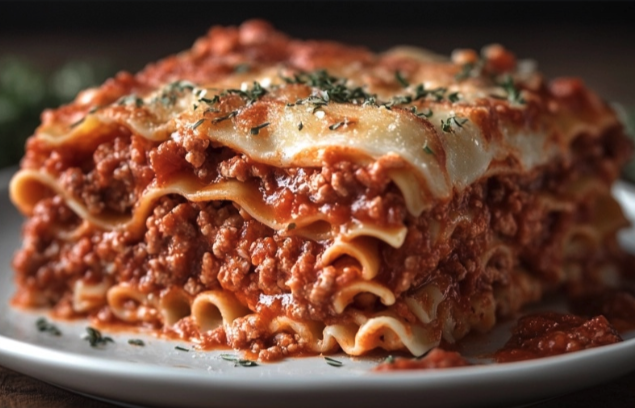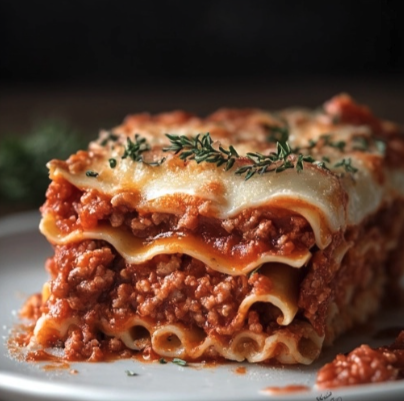 Pin it
Pin it
This classic Italian beef lasagna recipe delivers layers of tender noodles, seasoned meat, and three cheeses for the ultimate comfort food experience. The slow-simmered tomato sauce creates a depth of flavor that makes this dish worth every minute of preparation.
I first made this lasagna for my husband on our first anniversary, and it has become our go to celebration dish ever since. The way the cheese pulls into those perfect strands when you serve it never fails to bring smiles to our table.
Ingredients
- Olive oil: creates the base for sautéing vegetables and developing flavor in the meat sauce
- Ground beef: choose 80/20 lean to fat ratio for the best flavor without excess grease
- Crushed tomatoes: San Marzano variety provides superior sweetness and less acidity
- Dried herbs: infuse the sauce with classic Italian flavors that permeate every layer
- Ricotta cheese: adds creaminess use whole milk ricotta for the richest texture
- Egg: helps bind the cheese layer together during baking
- Parmesan cheese: aged varieties provide that nutty umami flavor throughout the dish
- Mozzarella cheese: creates those iconic stretchy cheese pulls low moisture works best
- Lasagna noodles: traditional style that need boiling beforehand ensures proper texture
Step-by-Step Instructions
- Aromatics Foundation:
- Cook the chopped onion in olive oil over medium heat for about 5 minutes until softened and translucent but not browned. This creates a sweet base flavor for the sauce that mellows the final dish.
- Meat Mixture Development:
- Add minced garlic and stir for 30 seconds until fragrant before incorporating the ground beef. Break the meat into small crumbles with a wooden spoon and cook thoroughly until no pink remains, about 7 minutes. The fine texture ensures proper distribution throughout the lasagna layers.
- Sauce Creation:
- Incorporate dried herbs, crushed tomatoes, sugar and seasonings into the meat mixture, stirring well to combine. Reduce heat to low and allow the sauce to simmer uncovered for a full 15 to 20 minutes, stirring occasionally. This reduction concentrates the flavors and thickens the sauce to the perfect consistency.
- Cheese Mixture Preparation:
- In a separate bowl, thoroughly combine ricotta cheese with the egg, half the Parmesan, salt and pepper until completely smooth. This step is crucial for creating a creamy middle layer that holds together when the lasagna is served.
- Oven Preparation:
- Preheat your oven to 375°F to ensure it reaches the proper temperature before the assembly is complete. This consistent heat ensures even cooking throughout the lasagna.
- First Layer Assembly:
- Spread approximately one cup of sauce across the bottom of a 9x13 inch baking dish, covering the entire surface. Arrange four cooked lasagna noodles slightly overlapping to create the first solid foundation.
- Building Middle Layers:
- Carefully spread half the ricotta mixture over the noodles using the back of a spoon or offset spatula. Sprinkle a layer of mozzarella evenly across the ricotta, then add another generous layer of meat sauce.
- Layer Repetition:
- Repeat the layering process a second time, placing another four noodles, remaining ricotta, more mozzarella, and additional sauce. This middle section provides the bulk of the lasagna's texture and flavor.
- Final Layer Construction:
- Place the final four noodles on top and cover completely with the remaining sauce. The top layer should be thoroughly coated to prevent noodles from drying out during baking.
- Baking Process:
- Cover the baking dish tightly with aluminum foil to trap steam and prevent the top from drying out during the initial baking. After 30 minutes, remove the foil and bake uncovered for an additional 15 minutes until the cheese becomes golden and bubbly with slightly crisp edges.
 Pin it
Pin it
The crushed tomatoes are truly the heart of this recipe. I learned from my Italian neighbor that adding just a pinch of sugar helps balance the acidity without making the sauce sweet. Every time I make this dish, I remember her teaching me to taste and adjust as the sauce simmers.
Make-Ahead Options
This lasagna actually improves with time, making it perfect for advance preparation. You can assemble the entire dish up to 24 hours before baking and store it covered in the refrigerator. Just add an extra 15 minutes to the covered baking time if cooking directly from the refrigerator. The flavors meld beautifully during this resting period, creating an even more cohesive final dish.
Serving Suggestions
A simple green salad dressed with lemon and olive oil provides the perfect acidic counterpoint to the rich lasagna. For a complete Italian feast, consider serving with garlic bread to soak up any remaining sauce on the plate. A medium-bodied red wine like Chianti or Montepulciano complements the tomato sauce wonderfully without overwhelming the subtle cheese flavors.
 Pin it
Pin it
Storing Leftovers
Once cooled completely, leftover lasagna can be refrigerated for up to 4 days in an airtight container. For best results when reheating, sprinkle a few drops of water over each portion before covering loosely with foil and heating in a 350°F oven until the center reaches 165°F. Microwaving works in a pinch, but tends to create uneven hot spots and can make the noodles tough.
Frequently Asked Questions
- → What makes this lasagna stand out?
The combination of a rich, herb-infused meat sauce, creamy ricotta, and bubbling mozzarella makes it delightfully flavorful.
- → Can I prepare this dish in advance?
Yes, you can assemble the lasagna a day ahead, refrigerate it, and bake it fresh when ready to serve.
- → What can I substitute for ricotta cheese?
You can use cottage cheese as a substitute, though it will have a slightly different texture.
- → How do I prevent the noodles from sticking together?
After cooking, rinse the noodles under cold water and lay them flat on a baking sheet to keep them separate.
- → Can I freeze leftover lasagna?
Yes, divide the leftovers into portions, wrap tightly, and freeze for up to 3 months for easy reheating later.
